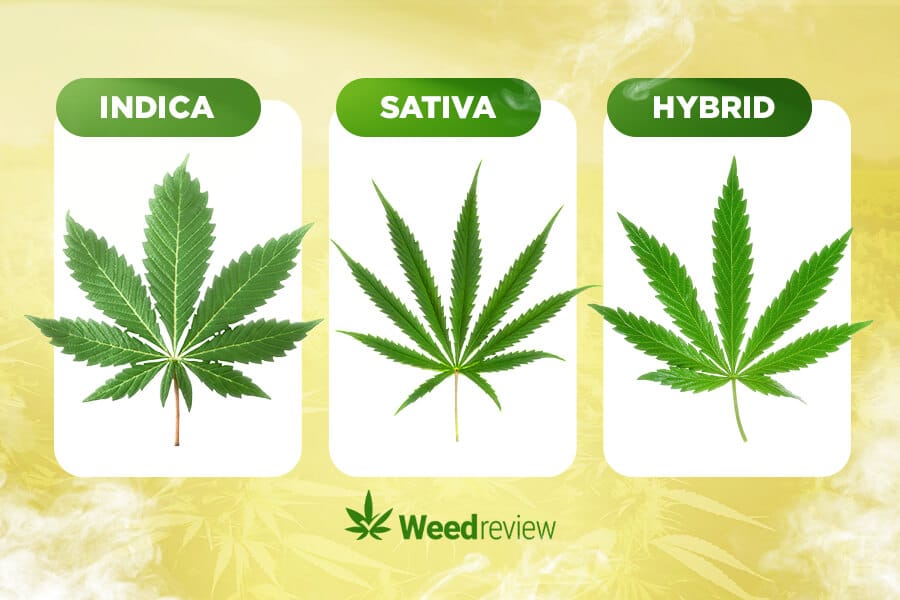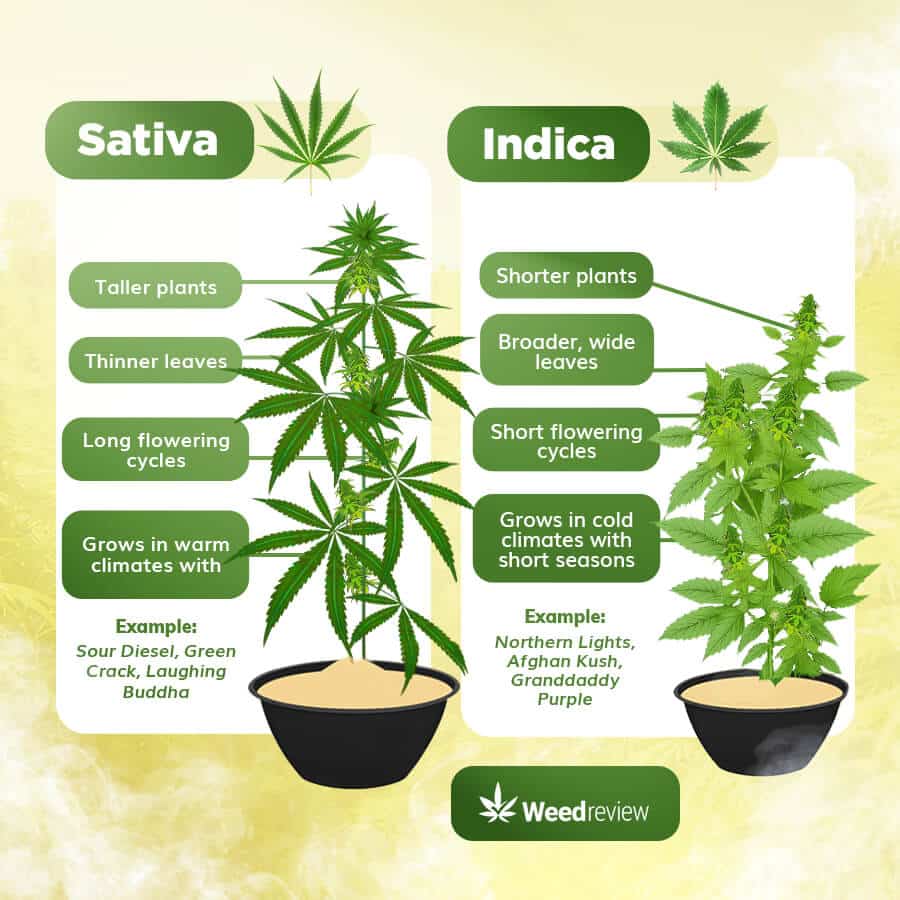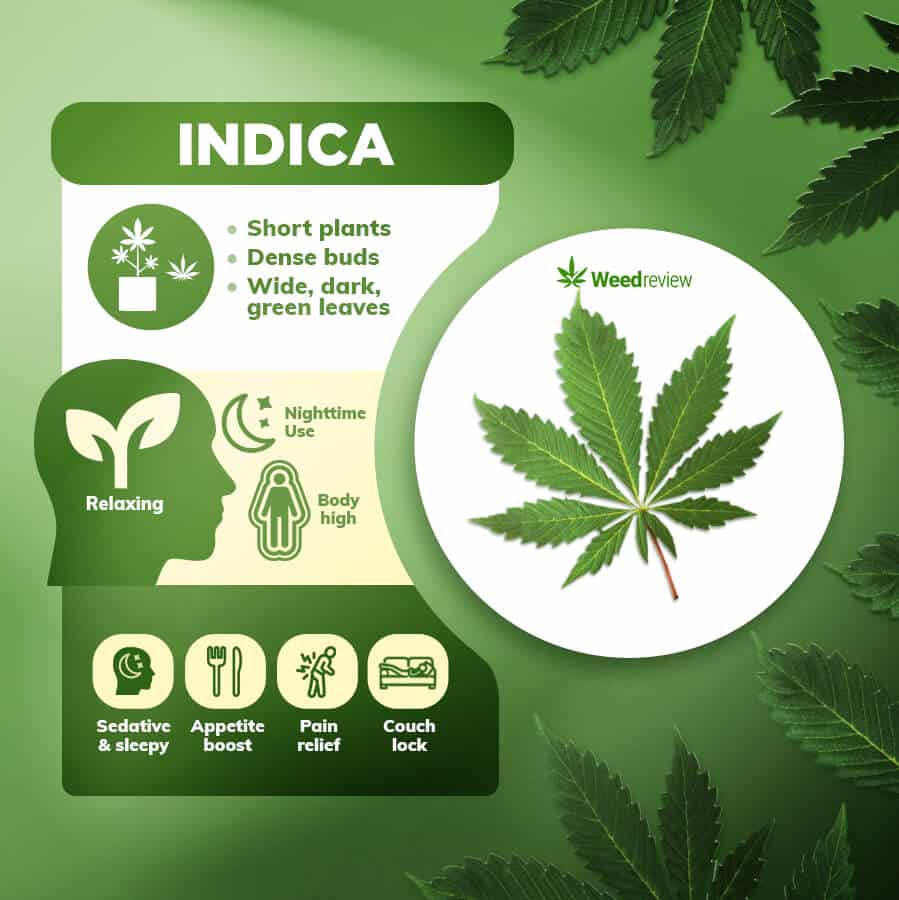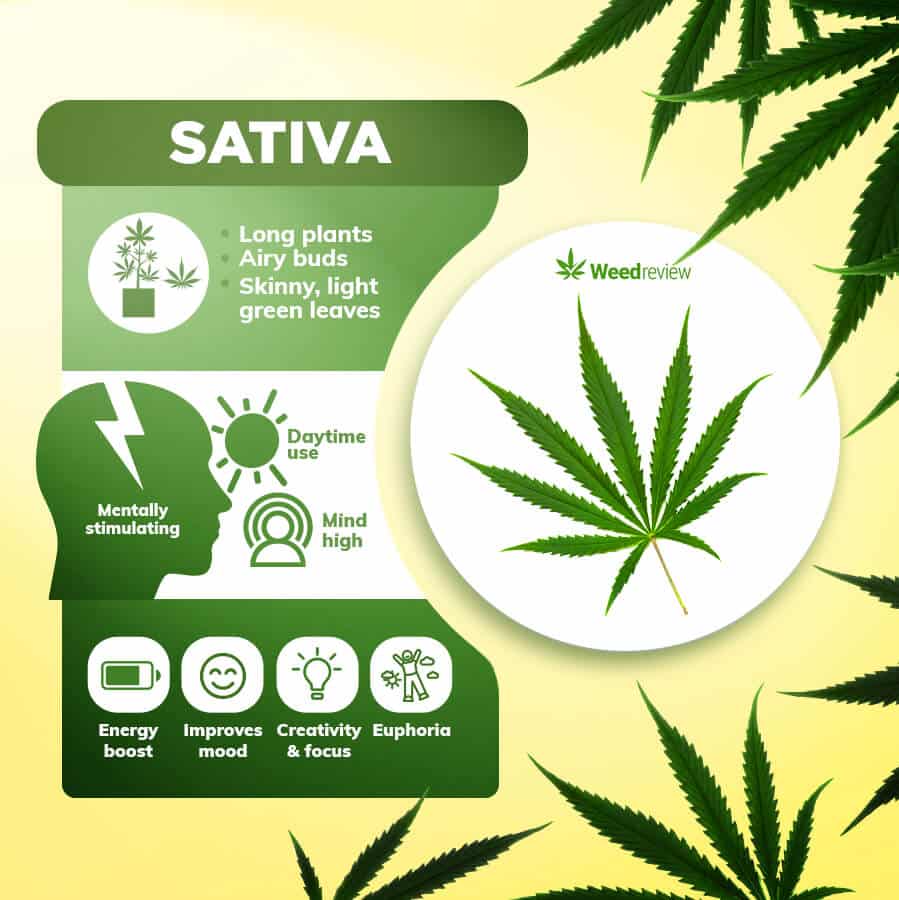
A Complete Guide to Indica, Sativa, and Hybrid Cannabis Strains

Table of Contents
Whether you want to buy weed or browse through different marijuana flowers, you will find three types of strains: Indica, Sativa, and hybrids. Almost all shops, dispensaries, and budtenders put their cannabis in one of the three buckets as a way to differentiate the effects.
Indicas offer a soothing, relaxing high, while Sativas are energising and uplifting. Hybrids are a combination of the two.
Science, however, does not entirely agree with this. A new way of classifying marijuana strains is emerging – one that looks at the cannabinoids and terpenes in the plant. These chemicals make up the profile that separates the effects of Pineapple Express from Blue Dream.
The Indica/Sativa classification is still popular and widely accepted. They are an excellent indicator of what to expect from a flower.
As you become more experienced in using cannabis, you will find that looking at THC/CBD ratios – the two major cannabinoids – and terpenes like myrcene or pinene can help you find your preferred strain more accurately.
In this article, we are going to look at all of these features in detail. Discover the unique qualities and effects that make Sativas and Indicas special, helping you navigate through the intriguing choices of marijuana.
Cannabis strains at a glance
The chart below gives you a brief overview of the main features of Indica, Sativa, and hybrid.
| Attributes | Indica | Sativa | Hybrid |
|---|---|---|---|
| Length | Short and bushy; 100-150 cm | Tall and slim; 150-300+ cm | Mixed characteristics |
| Leaves | Thicker fan leaves | Thin fan leaves | Mixed features |
| Flowers | Dense flowers | Fluffier flowers | Mixed features |
| Growing | Ideal for indoors | Ideal for outdoors | Indoors & outdoors |
| Yield | Medium | Large | Depends on the genes |
| Flowering time | Short | Long | Varies |
| Type of high | Body high | Cerebral high | Mixed high |
| Uses | Appetite, pain relief, sleep | Easing stress, energy boost, creative high | Versatile; helps body and mind |
- People new to marijuana can use this as an indication of what to expect when they smoke weed.
- Farmers and growers can also use this guide to pick their ideal variety for cultivation.

The origins & taxonomy of Indica vs. Sativa
In the year 1753, a botanist named Carl Linnaeus set out to bring order to the world of plants. He published a book called ‘Species Plantarum,’ where he organized various plants into groups. Among them was cannabis, which he labelled as “Cannabis sativa L.” Think of it as giving each plant a first name/genus (sativa) and a family name/species (Cannabis), with Linnaeus’ signature (L.) to mark his work.
Fast forward to around 1785, a French biologist named Jean-Baptiste Lamarck took this classification a step further. He realised that not all cannabis plants were the same. Some were tall and had a slender build, like a basketball player. Others were shorter and looked more robust.
Lamarck decided to give these different types distinct names. The tall ones were called ‘Cannabis Sativa,’ while the shorter, stockier ones were labelled ‘Cannabis Indica.’
You should note that the Sativa/Indica classification was established on the botany of the plants – their physical appearances. No hard data about their chemical make – cannabinoids and terpenes – was obtained back then. Through the years, this classification stuck and became the norm.
Indica strains
Indica strains originated in the Northern parts of India and the Afghan mountains. These cannabis plants lived in cool climates and had short growing seasons.
Most people select Indica strains if they need help with chronic pain, anxiety, insomnia, and appetite issues.
Physical characteristics
Contrary to Sativas, Indica plants are short and bushy, often growing between 60-150 cm tall.
The area where Indicas came from had short daylight hours during winter, leading the plant to flower quickly and make use of the light as much as it can.
That is why they have broad leaves that are a deep green. Some varieties will display purple in the leaves towards the end of the flowering cycle. The buds are generally denser than those of a Sativa strain.
Indicas are ideal for growing indoors or in conditions where space is a problem.
Effects
An Indica is for those looking for a body-focused high that promotes relaxation and helps you get to sleep.

Indicas tend to have low-to-medium concentrations of THC – the main psychoactive component of marijuana – with notable levels of CBD. In fact, this presence of cannabidiol is also why Indicas give a strong sedative high.
As a result, these varieties are also a favourite among medical cannabis users looking to ease medical conditions. Ideal for evening/nighttime use, it can also help with:
- Nausea reduction
- Increased appetite
- Easing of anxiety
- Pain relief (from acute and chronic pain)
- Reduced insomnia
Popular strains
- Northern Lights: Probably the most famous Indica strain ever. It displays all of the classic Indica effects; it is best for stress relief and helps with sleeping.
- Grandaddy Purple: An almost-pure Indica that smells of grapes and berries. The flowers tend to have beautiful purple hairs that deliver a strong sedative effect.
- Afghan Kush: A strain with deep sedative effects. It also provides a mood-enhancing euphoric high. It excels at pain management and helping people overcome insomnia.
Sativa strains
The origins of a Sativa strain start in a much hotter climate, closer to the equator – like those seen in Thailand. It is also why Thai landraces are famous – they are among the original Sativas.
These plants have a longer growing season and enjoy high temperatures and humidity.
Sativa varieties are more geared toward the mind, providing a euphoric, uplifting high. They can help ease your stress and anxiety, reduce fatigue and laziness, and boost your energy levels.
Physical characteristics
Sativa strains grow much taller than Indica, often reaching heights between 150-300 cm tall. In some cases, they can even grow as tall as 5 metres.
This is because of the abundance of sunlight. Since winters in tropical regions hardly affect how much light the plants can receive, Sativas get all the time and freedom in the world to grow to their best ability. This also meant much higher yields when compared to Indicas.
Sativas are tall, slender plants with skinny fan leaves that are often light green. There will be fewer branches and fluffier buds. As such, they are recommended for outdoor growth or settings where there is plenty of space.
Effects
The effects of a Sativa will produce a head high, which makes people feel energised and motivated. This is due to the high concentration of THC with low amounts of CBD.

These strains are great for daytime use to help improve focus. Other common effects can include:
- Easing headaches and nausea
- Higher appetite
- Easing of depression and anxiety
- Boost in creativity
- Better motivation & inspiration
Popular strains
- Jack Herer: A high-producing strain that is both sweet and earthy. It is a good strain for boosting energy in the morning.
- Sour Diesel: Another classic Sativa that is known for its energising high.
- Durban Poison: A famous landrace Sativa originating in South Africa; people use it for a creative and social experience.
Hybrid strains
A hybrid strain is created by breeding different strains together. Most commonly, you’ll find an Indica and Sativa crossed with each other to come up with an entirely new strain.
It is highly likely that every strain in the market is a hybrid because the plants have been crossbred so many times in the last 100 years. What you see in your local weed shops are Indica-dominant or Sativa-dominant hybrids.
Physical characteristics
The physical characteristics will change depending on the parent plants. For example, if the hybrid is Indica-dominant, then it might have skinny leaves with a small, bushy stature.
The final physical features will often reflect whichever strain has the more dominant genetics.
Effects
Hybrid varieties combine the benefits of both Indica and Sativa strains – they provide the pain-relieving, sedative effects of Indica and the mental alertness associated with Sativa.
Hybrids may also provide a stronger high than straight Indica and Sativa strains.
Popular strains
- Gorilla Glue: A potent Indica-dominant strain that is heavily sedating. Users report feeling like they are glued to their couch after consuming this strain.
- Chemdawg: Known for its strong high, and pungent aroma, it is a Sativa-dominant hybrid that is used to create other strains like sour diesel.
- Gelato: An Indica-dominant hybrid that is known for Sativa-like flavours such as berries, citrus, and flowers. It is a relaxing strain that reduces anxiety and depression.
Cannabis ruderalis
Cannabis ruderalis, often overshadowed by its more famous counterparts, is a modest yet intriguing member of the cannabis family. Originating in regions with harsh climates like Russia, this lesser-known variety has developed unique survival traits.
While ruderalis plants may not boast the high potency of Sativa or the calming effects of Indica, they have an adaptive quality that sparks interest among breeders.
Its natural ability to flower regardless of light cycles, known as ‘auto-flowering,’ has led to its use in creating hybrid strains. These varieties are resilient to pests and diseases and do not depend on the light times to flower – instead, they start producing buds based on age.
Indica vs. Sativa: What is right for you?
The simplicity of this method means you don’t have to do much research. You simply need to ask yourself what kind of experience you are looking for:
- Do you want to use it for medical purposes?
- Do you seek a recreational, fun high for a night of partying?
- Do you want to improve your creativity and focus so you can work better?
- Have you smoked cannabis before?
- Are you a daytime or a nighttime user?
- How long do you want the high to last?
As a rule of thumb:
- Indica is the chill companion. These flowers could be your best bet if you’re looking to wind down after a long day, ease stress, or simply melt into the couch. Indicas are commonly associated with body sensations, making them a go-to choice for pain relief and a peaceful night’s sleep.
- Sativa is the energising partner. When you need a boost of creativity, want to tackle a busy day, or simply enjoy a lively social experience, sativas might be your go-to. They create a cerebral high that sparks inspiration, ups your focus, and keeps you active.
- Hybrid is the best of both worlds. They can lean more towards one side or strike a balance between relaxation and energy. They’re perfect for those looking to explore different dimensions of cannabis effects.
You must also consider the THC/CBD concentrations of these varieties.
For example, Northern Lights and Granddaddy Purple are two Indica flowers but with different THC levels, thus leading to different effects. The first bud may offer a mellow trip, while GDP may prove to be highly sedative and potent. This is where chemovar classification offers a clearer picture.
Chemovar classification: A more accurate way to look at marijuana
In the world of cannabis, we group strains into categories like Sativa, Indica, and hybrid to understand how they make us feel. But now, we’re discovering a smarter way to look at it called chemovar classification.
This new idea understands that the effects of marijuana are due to the special mix of stuff inside it, like chemicals called cannabinoids and terpenes. These chemicals create different feelings and highs when we use cannabis.
The three chemovar types
Chemovar classification brings forth a refined understanding of cannabis by categorising strains into three primary types based on their dominant chemical profiles:
- Type 1 – High-THC chemovars: These chemovars boast a high concentration of THC, the cannabinoid responsible for the euphoric and psychoactive effects of cannabis. Flowers like Gelato, AK 47, and Bruce Banner fall in this category.
- Type 2 – High-CBD chemovars: Chemovars of this type are characterised by high levels of CBD, a non-psychoactive cannabinoid known for its potential therapeutic benefits. These strains are often favoured by medical cannabis patients. Common examples are Remedy, Harlequin, and Charlotte’s Angel CBD.
- Type 3 – Balanced chemovars: Striking a harmonious equilibrium between THC and CBD, these 1:1 chemovars offer a well-rounded experience that combines the potential benefits of both cannabinoids. They cater to those seeking a balanced and versatile cannabis encounter.
This approach aligns with the work of Dr. Ethan Russo, a pioneer in cannabis research. He proposed the theory of the “entourage effect”, which emphasises the interplay between cannabinoids and terpenes.
Dr. Russo has stated that traditional Sativa/Indica classifications are an oversimplification and that the biochemical content of a plant cannot be predicted solely by its physical appearance.
The role of terpenes
Terpenes, the chemicals that give cannabis its unique smells and flavours, are actually pretty important for how cannabis affects us too.
For example, think about Indicas that make you feel all relaxed and sleepy – a lot of that chill vibe comes from something called myrcene, which is a common terpene in indicas. Myrcene brings a sense of calm and relaxation, often making you want to just chill on the couch.
Now, on the flip side, there’s another terpene called limonene. This one is like a mood booster! Limonene is often found in strains that make you feel happy, energetic, and upbeat. So, if you’re looking for a little pick-me-up, a strain with limonene could be your go-to choice.
When we put all this together with chemovar classification, it’s like having a secret decoder for cannabis effects. Knowing the terpenes in a strain can help you choose the right one for your mood or needs.
If you want to unwind, look for myrcene-rich indicas. If you’re aiming for a positive vibe, seek out strains with limonene.
It’s like having a personalised menu of cannabis experiences! This knowledge gives you the power to confidently explore the world of cannabis strains in a way that’s smart and precise.
Conclusion
The conventional designations of Sativa, Indica, and Hybrid serve as foundational building blocks in the diverse world of cannabis.
These classifications remain relevant today, with consumers making purchase decisions based on the expected body-focused high of Indicas, the mentally stimulating effects of Sativas, and the balanced effects offered by hybrids.
But now, the canvas has evolved into a masterpiece of understanding with chemovar classification. This advanced approach peels back the layers, revealing the intricate dance of chemicals like cannabinoids and terpenes that truly shape the effects of each strain.
You should use the Sativa/Indica way when you are new to using marijuana. As you become an experienced user, let the chemovar classification be your compass.
Think of it as a treasure map to your desired experience – a journey where you’re not limited to just Indica or Sativa but where you can curate your own adventure. With each terpene and cannabinoid playing a unique role, the world of cannabis becomes a playground of possibilities, waiting for you to explore and savour.



